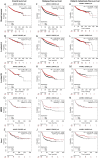The roles of anti-Müllerian hormone in breast cancer
- PMID: 37410375
- PMCID: PMC10448580
- DOI: 10.1530/ERC-23-0060
The roles of anti-Müllerian hormone in breast cancer
Abstract
Anti-Müllerian hormone (AMH) is produced and secreted by granulosa cells of growing follicles, and its main role is to inhibit the recruitment of primordial follicles, reduce the sensitivity of follicles to follicle-stimulating hormone (FSH), and regulate FSH-dependent preantral follicle growth. It has become an effective indicator of ovarian reserve in clinical practice. Research on AMH and its receptors in recent years has led to a better understanding of its role in breast cancer. AMH specifically binds to anti-Müllerian hormone receptor II (AMHRII) to activate downstream pathways and regulate gene transcription. Since AMHRII is expressed in breast cancer cells and triggers apoptosis, AMH/AMHRII may play an important role in the occurrence, treatment, and prognosis of breast cancer, which needs further research. The AMH level is a potent predictor of ovarian function after chemotherapy in premenopausal breast cancer patients older than 35 years, either for ovarian function injury or ovarian function recovery. Moreover, AMHRII has the potential to be a new marker for the molecular typing of breast cancer and a new target for breast cancer treatment, which may be a link in the downstream pathway after TP53 mutation.
Keywords: anti-Müllerian hormone; anti-Müllerian hormone receptor II; breast cancer; hypothalamic–pituitary–ovarian axis; ovarian function.
Conflict of interest statement
All authors declare that they have no conflicts of interest.
Figures







Similar articles
-
Anti-müllerian hormone and anti-müllerian hormone type II receptor messenger ribonucleic acid expression in rat ovaries during postnatal development, the estrous cycle, and gonadotropin-induced follicle growth.Endocrinology. 1995 Nov;136(11):4951-62. doi: 10.1210/endo.136.11.7588229. Endocrinology. 1995. PMID: 7588229
-
Expression of Müllerian-Inhibiting Substance/Anti-Müllerian Hormone Type II Receptor in the Human Theca Cells.J Clin Endocrinol Metab. 2018 Sep 1;103(9):3376-3385. doi: 10.1210/jc.2018-00549. J Clin Endocrinol Metab. 2018. PMID: 29947765
-
Anti-Müllerian hormone reduces growth rate without altering follicular survival in isolated caprine preantral follicles cultured in vitro.Reprod Fertil Dev. 2017 Jun;29(6):1144-1154. doi: 10.1071/RD15290. Reprod Fertil Dev. 2017. PMID: 27166082
-
Interactions between androgens, FSH, anti-Müllerian hormone and estradiol during folliculogenesis in the human normal and polycystic ovary.Hum Reprod Update. 2016 Nov;22(6):709-724. doi: 10.1093/humupd/dmw027. Epub 2016 Aug 27. Hum Reprod Update. 2016. PMID: 27566840 Review.
-
Anti-Müllerian Hormone: genetic and environmental effects.Clin Chim Acta. 2018 Jan;476:123-129. doi: 10.1016/j.cca.2017.11.027. Epub 2017 Nov 23. Clin Chim Acta. 2018. PMID: 29175649 Review.
Cited by
-
Anti-Müllerian hormone: biology and role in endocrinology and cancers.Front Endocrinol (Lausanne). 2024 Sep 16;15:1468364. doi: 10.3389/fendo.2024.1468364. eCollection 2024. Front Endocrinol (Lausanne). 2024. PMID: 39351532 Free PMC article. Review.
-
AMH regulates granulosa cell function via ESR2/ p38-MAPK signaling pathway in sheep.Commun Biol. 2025 May 29;8(1):824. doi: 10.1038/s42003-025-08259-6. Commun Biol. 2025. PMID: 40442469 Free PMC article.
-
The emerging roles of long noncoding RNAs in lymphatic vascular development and disease.Cell Mol Life Sci. 2023 Jul 6;80(8):197. doi: 10.1007/s00018-023-04842-4. Cell Mol Life Sci. 2023. PMID: 37407839 Free PMC article. Review.
References
-
- Baarends WM Uilenbroek JT Kramer P Hoogerbrugge JW van Leeuwen EC Themmen AP & Grootegoed JA. 1995Anti-Müllerian hormone and anti-Müllerian hormone type II receptor messenger ribonucleic acid expression in rat ovaries during postnatal development, the estrous cycle, and gonadotropin-induced follicle growth. Endocrinology 1364951–4962. (10.1210/endo.136.11.7588229) - DOI - PubMed
-
- Bao B Garverick HA Smith GW Smith MF Salfen BE & Youngquist RS. 1997Changes in messenger ribonucleic acid encoding luteinizing hormone receptor, cytochrome P450-side chain cleavage, and aromatase are associated with recruitment and selection of bovine ovarian follicles. Biology of Reproduction 561158–1168. (10.1095/biolreprod56.5.1158) - DOI - PubMed
Publication types
MeSH terms
Substances
LinkOut - more resources
Full Text Sources
Medical
Research Materials
Miscellaneous

